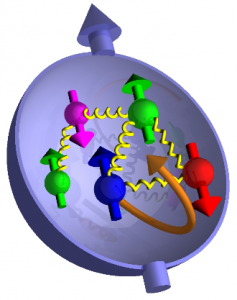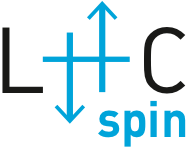 There has been a vigorous and global program of experiments and theoretical developments in the last 25 years aimed at understanding the internal spin structure of the proton. Tremendous progress has been made with unraveling proton’s spin structure with advances in experimental techniques and theoretical models. However the problem is still far from its solution.
There has been a vigorous and global program of experiments and theoretical developments in the last 25 years aimed at understanding the internal spin structure of the proton. Tremendous progress has been made with unraveling proton’s spin structure with advances in experimental techniques and theoretical models. However the problem is still far from its solution.
Particles with spin different from zero behave like spinning tops, but unlike the classical spin of a top, the spin of the proton and of the other elementary particles is an intrinsic quantum phenomenon. It is responsible for many fundamental properties like separate the particles responsible of building the matter (fermions) and the ones mediating the forces (bosons) and of many phenomena like, among several of them, the proton’s magnetic moment and the phases of low-temperature matter.
However, even if the spin was formulated for the first time by W. Pauli in the far 1925, how the total spin is built up in the non-elementary particles (like indeed protons and neutrons) is still unknown. The protons and the neutrons are the bricks of the atomic nucleus and are described in quantum chromodynamics (QCD, the theory of quarks and gluons) by an inner core of three confined valence quarks, a sea of virtual quark-antiquark pairs and gluons, all surrounded by a diffuse cloud of virtual pions. In general, the spin of the proton is built up from the intrinsic spin of the valence and sea quarks (each 1/2) and the gluons (spin 1) and their orbital angular momentum, where spin is measured in units of Planck’s constant. The challenge is to understand how these contributions combine to yield the total spin 1/2 of the proton or the neutron. In the early time it was thought the valence quarks were responsible of most the total spin of non-elementary particles as it happens for the electrical charge, the mass and the momentum. Unfortunately the situation is much more complicated: the relativistic motion of all quarks and gluons forming the complex particles means that they each carry orbital momentum, moving and rotating inside the particle.
First generation high-energy particle-scattering experiments like EMC, HERMES, JLab and COMPASS have found that the quark contribution to the proton (30%) comes entirely from the valence quarks; there’s just a very small contribution from the quark-antiquark sea. The quark spin content deduced from these experiments could be so small for several reasons. For instance gluon spin can screen the total quark spin contribution through a quantum effect called the axial anomaly or a topological effect can delocalize the quark spin inside the proton so that it is, in part, invisible to scattering on individual and localized quarks.
Therefore the study of the gluon spin is useful in understanding both its share in the total spin budget and the size of the axial-anomaly effect. Experiments in the last decade at CERN and RHIC in US have provided valuable information on the proton’s gluon spin. The spin and orbital contributions to the proton’s spin depend on how deeply one probes inside the proton: what appears as a single valence quark at low resolution emerges at higher resolution as a valence quark surrounded by a sea of quark-antiquark pairs and gluons. The latters will carry spin and orbital angular momentum too. When one probes deeper inside the proton, and thus sees a greater number of gluons, the angular momentum summed over all of the proton’s constituent particles is always conserved.
Yi-Bo Yang from the University of Kentucky, Lexington, and colleagues have developed, for the first time, computer simulations aimed to estimate the gluon contribution to the proton’s spin. Their results, appeared Physics Review Letters 118, 102001 (2017)[1], indicate that about 50% of the proton’s spin comes from the spin of the gluons that bind its quark constituents.
Understanding the structural complexity of protons and neutrons in terms of quarks and gluons is one of the most important challenges facing physics today motivating the new generation of experimental facilities, including the already running JLab12 (US) and COMPASS2 (CERN), which see an important participation of the Italian community of scientists.
Besides this fundamental problem, a new fascinating challenge is facing out the physics community. When in the early ’70s the first 3D computed tomographic apparatus was introduced, it revolutionized medical imaging and the diagnostic of radiography. The state of art in the field of particle physics is still based on a one-dimensional description of the particles internal structure and, in particular, of the protons and the neutrons. The investigation of subatomic structure and the particle physics field at large can be revolutionized by making three-dimensional probes available. To achieve this it is necessary to make use of the spin. It is the new tool for investigating the tomographic structure of protons and neutrons, opening a new window on the frontier physics.
To arrive at this important result several technical and physics achievements have to be reached, going for the material science for coating the inner walls of the accelerator pipe, to new reconstruction algorithms for the particle tracks.

The Laboratori Nazionali di Frascati, together with the University of Ferrara, are playing a very important role in this research, developing and proposing, for the first time, a project called LHCSpin, giving the possibility to have polarized particle collisions (meaning collisions depending on the spin) at the most powerful collider ever built, the LHC at CERN. The project is still in its preparatory phase, however, everybody hopes that, in the next years, under the INFN coordination, in a synergic effort with other research institutions like CERN (Swiss), the Research Center Juelich (Germany), the University of Erlangen (Germany) and the University of Virginia (USA), LHCSpin will shine the light on the particle spin puzzle giving precious information of the tomographic description of protons and neutrons. (Pasquale Di Nezza)
[1] Freely avalaible at arxiv.org/abs/1606.05937
Translation by Camilla Paola Maglione, Communications Office INFN-LNF
 INFN-LNF Laboratori Nazionali di Frascati
INFN-LNF Laboratori Nazionali di Frascati